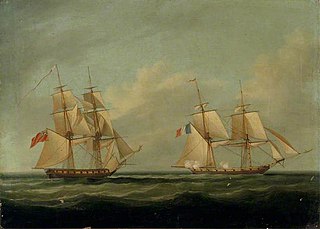Vénus was a corvette of the French Navy that the British captured in 1800. Renamed HMS Scout, she served briefly in the Channel before being wrecked in 1801, a few days after taking a major prize.
HMS Staunch was a Royal Navy 12-gun Archer-class gun-brig, built by Benjamin Tanner and launched in 1804 at Dartmouth, Devon. She served in the Indian Ocean and participated in the action of 18 September 1810 before she foundered with the loss of all hands in 1811.

HMS St Lawrence was a 14-gun schooner of the Royal Navy. She had been built in 1808 in St. Michaels, Talbot County, Maryland for Thomas Tennant and sold to Philadelphians in 1810.During the War of 1812 she was the US privateer Atlas. The UK captured her in 1813 and renamed her St Lawrence. The US privateer Chasseur recaptured her in 1815, and then HMS Acasta re-recaptured her.

HMS Ferret was a Royal Navy Cruizer-class brig-sloop built by Benjamin Tanner at Dartmouth and launched in 1806, 19 months late. She served on the Jamaica, Halifax, and Leith stations during which time she took three privateers as prizes before she was wrecked in 1813.
HMS Barracouta was a Royal Navy Ballahoo-class schooner. The prime contractor for the vessel was Goodrich & Co., in Bermuda, and she was launched in 1804. Like many of her class and the related Cuckoo-class schooners, she succumbed to the perils of the sea relatively early in her career.
HMS Capelin was a Royal Navy Ballahoo-class schooner carrying four 12-pounder carronades and a crew of 20. The prime contractor for the vessel was Goodrich & Co., in Bermuda, and she was launched in 1804. Like many of her class and the related Cuckoo-class schooners, she succumbed to the perils of the sea relatively early in her career.
HMS Pike was a Royal Navy Ballahoo-class schooner of four 12-pounder carronades and a crew of 20. The prime contractor for the vessel was Goodrich & Co., in Bermuda, and she was launched in 1804. She captured one 10-gun enemy vessel before being herself captured, and recaptured.
HMS Chub was a British Royal Navy Ballahoo-class schooner of four 12-pounder carronades and a crew of 20. The prime contractor for the vessel was Goodrich & Co., in Bermuda, and she was launched in 1807. She and her crew were lost when she was wrecked in August 1812.

HMS Haddock was a Royal Navy schooner of four 12-pounder carronades and a crew of 20. The prime contractor for the vessel was Goodrich & Co., in Bermuda, and she was launched in 1805.
On Thursday 21st inst launched off the stocks at Mr Isaac Skinner's shipyard his Majesty's Schooner "Haddock". The above schooner is said to be the completest vessel ever built in Bermuda
HMS Crane was a Royal Navy Cuckoo-class schooner of four 12-pounder carronades and a crew of 20. She was built by Custance & Stone at Great Yarmouth and launched in 1806. Like many of her class and the related Ballahoo-class schooners, she succumbed to the perils of the sea relatively early in her career.
HMS Pigeon was a Royal Navy Cuckoo-class schooner. Custance & Stone built and launched her at Great Yarmouth in 1806. Like many of her class and the related Ballahoo-class schooners, she succumbed to the perils of the sea relatively early in her career.
HMS Widgeon was a Royal Navy Cuckoo-class schooner built by William Wheaton at Brixham and launched in 1806. Like many of her class and the related Ballahoo-class schooners, she succumbed to the perils of the sea relatively early in her career.
HMS Cuckoo was a Royal Navy Cuckoo-class schooner of four 12-pounder carronades and a crew of 20. She was built by James Lovewell at Great Yarmouth and launched in 1806. Like many of her class and the related Ballahoo-class schooners, she succumbed to the perils of the sea relatively early in her career.
HMS Whiting was a Royal Navy Ballahoo-class schooner of four 12-pounder carronades and a crew of 20. The prime contractor for the vessel was Goodrich & Co., in Bermuda, and she was launched in 1805. She was a participant at the Battle of Basque Roads. A French privateer captured her at the beginning of the War of 1812, shortly after the Americans had captured and released her in the first naval incident of the war.
HMS Dominica was the French privateer schooner J(T?)opo L'Oeil that the British captured in 1807 in the Leeward Islands. She took part in one inconclusive single-ship action before she foundered in 1809.

HMS Seaforth was the French privateer Dame Ernouf, which HMS Curieux captured in 1805. The Royal Navy took her into service, but she foundered later that year.

The French schooner Impériale was a 3-gun mercantile schooner-aviso of the French Navy commissioned at Guadeloupe on 23 September 1805. The Royal Navy captured her on 24 May 1806 and named her HMS Vigilant. The Navy renamed her HMS Subtle on 20 November 1806. She wrecked at Bermuda on 20 October 1807.
HMS Plumper was launched in 1807. She captured three small American privateers early in the War of 1812 but was wrecked in December 1812.
HMS Nautilus was launched at Milford in 1804 as the only member of her class of sloops. She had a minor career capturing a handful of merchantmen. She was wrecked on 5 January 1807 with great hardship for the survivors and loss of life.
HMS Sparkler was launched in 1804 at Brightlingsea. Lieutenant James S.A.Dennis commissioned her in August 1804 for the North Sea.




